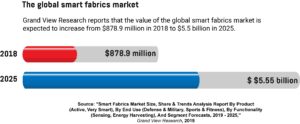- Smart fabric that automatically reacts to temperature and humidity
- Chinese researchers found a way to make smart textiles resilient and more comfortable
- Smart clothing that tracks the wearer’s movement
- Google’s Jacquard fabric provides easy access to the digital world
- Clothing could soon interact with the wearer through touch
- The future of smart textiles
Advances in the area of nanotech have powered the development of smart clothing, which merges electronics with textiles. In the past, smart clothing was mostly praised for its innovation, but rarely for its aesthetics. That’s starting to change, though, with new solutions in the field proving that high-tech clothing can be both innovative and aesthetically pleasing. However, factors such as high cost and lack of consumer awareness still create challenges for smart clothing manufacturers.
Despite these issues, smart garments designed to measure the wearer’s physiological activity, prevent injuries, or monitor health are a growing market. According to a report released by the business consulting firm Grand View Research, the global smart fabrics market was worth $878.9 million in 2018, and it’s expected to reach $5.55 billion by 2025, with North America having the largest market share. Clearly, this new breed of technology has great potential to change the fashion industry in the future, and with recent breakthroughs in the field, that future is closer than we think.

Smart fabric that automatically reacts to temperature and humidity
Humans absorb and release heat through infrared radiation, which is invisible to the human eye. To capture this energy, we wear warmer clothes in the winter, and we switch to lightweight clothing in the summer to release it. But in our hectic world, we often transition from warm to cold environments and vice versa on a regular basis. To regulate heat, we either put on more clothes, or take some off. However, there may be a better way to adapt to an unpleasantly warm commute or a chilly office.
In a study published recently in the journal Science, researchers from the University of Maryland (UM) describe a fabric that can react to temperature and humidity and automatically adjust how much heat passes through it. Depending on the conditions, the fabric will either cool or insulate the wearer’s body. It’s embedded with a special, infrared-sensitive yarn coated with carbon nanotubes. In case the person wearing this fabric gets hot or sweaty, the nanotubes will constrict, creating gaps and making the garment more breathable. If the wearer feels cold, the nanotubes will expand to capture heat. “Now you can have a one-base-layer garment that can keep you comfortable in a wider range of temperatures and wider range of activities,” says a co-author of the study, YuHuang Wang.
The researchers also claim their smart fabric was able to adjust heat radiation by more than 35 percent. The team is determined to begin testing their innovation later this year, but before it’s commercialised, more work needs to be done. This includes improving the design capabilities and reducing the cost of the fabric. The good thing is that most of the materials used to create the fabric are already widely available, and the carbon coating can be added during the dying process. So, this fabric might be heading towards successful commercialisation.
Chinese researchers found a way to make smart textiles resilient and more comfortable
Smart textiles are an exciting technology, but when it comes to incorporating them into our everyday lives, their lack of resilience becomes an issue. They need to be able to withstand a wide range of conditions that can damage and wear out the clothing. From sweaty workouts to washing and drying, smart textiles need to have great mechanical strength to endure all of those conditions. Luckily, researchers from the Nanjing University of Posts and Telecommunications in China have come up with a solution. Their research, published in the journal Nano, reveals how they used a simple and low-cost method to develop self-assembling silver nanowires with “uniform morphology, high conductivity and good mechanical strength”.
Smart textiles usually contain yarn and conductive fibres that are made from copper or stainless steel, and are very brittle and stiff. Since silver nanowires (Ag NWs) allow flexibility, they emerged as a better alternative, but engineering them into conductive fibers in a cost-effective way is a challenge. That’s why the Chinese researchers decided to look for inspiration in the human cardiovascular system and our capillaries. By harnessing the capillary action of fibres such as cotton, a solution containing silver nanowires “is spontaneously absorbed into the capillary tunnels”. Through evaporation-induced flow and a self-assembly process, conductive fibres that are still flexible and stretchable are formed. This breakthrough could help companies and manufacturers of high-tech garments to develop more comfortable and resilient smart textiles.
Smart clothing that tracks the wearer’s movement
Xenoma, a company manufacturing wearables and electronics, recently teamed up with the German Research Center for Artificial Intelligence (DFKI), and WearHEALTH, a research group from Technische Universität Kaiserslautern (TUK), to create smart clothes equipped with sensors and motion capture technology. These innovative smart garments can be used for a variety of purposes, including rehabilitation, sports, and everyday life.

Xenoma’s smart pants, for instance, are designed to track the wearer’s movement and mobility in the lower extremities. As the person moves, sensors inside the smart pants track motion and capture data about ankle and knee flexion, hip rotation, hip flexion, and hip abduction. The designers have made the clothing look like any other jogging pants, so it could be used as an everyday clothing item. Plus, it’s easy to put on and won’t disturb the wearer’s movements. “Xenoma’s hardware represents a perfect integration of sensor technology into clothing, so that intelligent technologies can actually be worn like ordinary everyday clothing,” says the head of wearHEALTH, Gabriele Bleser.
This isn’t the first time that Xenoma experimented with smart clothing. At CES 2018, the company showcased smart pajamas created for hospital patients. This innovative solution allows care providers to measure patients’ vital signs and detect when they’re moving thanks to sensors embedded into the shirt and pants. Xenoma’s smart pajamas can be washed more than 100 times, after which the clothing will start showing signs of wear and tear. It’s still a prototype, but the company plans to make it available for medical use by 2020, when it will cost less than $100.
Google’s Jacquard fabric provides easy access to the digital world
Since people want access to the digital world at all times, Google decided to provide this access through clothing. The tech giant created extremely thin conductive alloys that can be integrated with synthetic and natural fibres. The fabric, called Jacquard, has the same aesthetics as regular textiles and can be used in any design. However, what makes clothing made from Jacquard interesting is that it can interact with electronic devices. To create its first product with this tech, Google partnered with Levi Strauss & Co.
The duo came up with the Commuter Trucker Jacket, targeted at cyclists. Many cyclists tend to use their phones while cycling, which can distract them and expose them to dangerous situations. Once the jacket is paired with an app, the user can use the app to assign abilities and commands to specific gestures. For instance, the wearer can tap on their wrist, and music will start playing. It also allows users to handle calls, navigate, and receive notifications. This prevents them from staring at their phones, which makes their commute a lot safer.
Clothing could soon interact with the wearer through touch
Besides connecting us to the digital world, smart fashion could soon provide us with touch feedback as well. This is what researchers from the University of Twente (UT) in the Netherlands have envisioned for the WEAFING (Wearable Electroactive Fabrics Integrated in Garments) project. They want to develop clothing that will be able to talk to the wearer through haptic stimulation. While similar tech already exists, it’s equipped with actuators and sensors that can be noisy and reduce comfort. UT’s researchers propose a more efficient solution.
Instead of relying on an electronic device attached to the garment, haptic feedback will be produced by a ‘textile muscle’ that’s woven directly into the fabric. This knitted muscle is made from yarn embedded with electroactive polymers that contract when exposed to electricity. But to work properly, they also need a special gel, which is currently being developed by one of UT’s partners, the University of Cergy-Pontoise in France. UT’s researcher Angelika Mader explains that the team needs to investigate “what voltage and frequency is needed to actuate” the textile muscles, and “find the right mechanics of how to apply pressure onto the skin”.
Though the project started only recently, and the research is at a nascent stage, the scientists believe they’ll achieve their goal by 2023, when WEAFING is expected to be completed. Once the tech is developed, it could be used in various applications, from sports and gaming to physiotherapy. It could also help people with visual impairment to better navigate, and it could be used to stimulate blood circulation in patients who need to lie in bed for a long time.

The future of smart textiles
Thanks to its ability to detect and respond to changes in its environment, smart clothing has many promising applications across industries. This innovative technology can measure and store data about the wearer’s movement and activity. It could be particularly useful to people who work in hazardous and dangerous environments, such as firefighters and military personnel. High-tech garments could easily collect information on environmental conditions, including heat and gases, to prevent injuries and reduce worker exhaustion. By merging fashion with technology, manufacturers can create both innovative and aesthetically pleasing garments. Since further technological advances could make the production process a lot cheaper and quicker, wearing a sweater that adjusts to your body temperature, or comfortable pants that monitor your movement throughout the day could soon emerge as a new fashion trend.
Share via:



